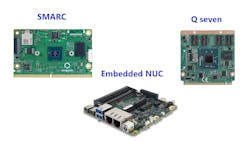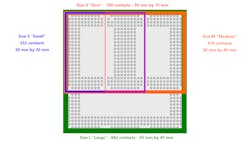Check out more Technology Talks videos.
SGET recently introduced a new computer-module standard, but it takes advantage of surace-mount technology (SMT). Version. 1.1 will be released at Embedded World, including a design guide for systems engineers. It's a great new standard.
I talked with Ansgar Hein, Chairman of the Board for SGET, about the new standard called Open Standard Module (OSM).
Links
Wong: So what does SGET stand for and what standards do you host now?
Hein: First of all, the Standardization Group for Embedded Technologies (SGET) is an international not-for-profit association of companies and organizations that collaboratively develop independent specifications for a better computer technology. It's our goal to provide a platform to develop open standards for the industry.
Wong: Okay. So what standards do you have now?
Hein: At present we host five different standards, mostly hardware-related, but one is a software-related standard. We're organized in standard development teams called SDTs, so each standardization working group is an entity and we have several standards that are quite well established like SMARC and Qseven (Fig. 1). We also have the Embedded NUC standard. The Universal IoT Connector is the software standard.
The latest addition to the pack is the Open Standard Model 1.1. So this is from our SDT 05.
Wong: Okay. But why do we need another computer-on-module standard like OSM?
Hein: Well, it's not another standard per se. It's about evolution. Today we have other possibilities than say 10 years ago when SGET was founded. So why not make use of the new possibilities that are out there? That was the driver behind creating another one. Making use of new possibilities.
Wong: Okay. So what are the advantages of using COMs in your design and in particular using OSM?
Hein: Well, the main advantage is that you have a solder-on module that's pretty much of a game changer because you do not have connectors anymore. It has all the same benefits that you have for the existing COM that are well established, such as open standards, low development, cost-efficient reuse of building blocks. Plus we add cost savings, automated testing, and automation in manufacturing. This is kind of a changer.
Wong: How can you quantify the cost savings of OEM or OEM customers compared to the Gen 1 COMs that are out there?
Hein: Well, to start there is no connector. Let's say the connector costs 1 euro to 5 euro per piece, maybe no manual testing. If you have a manual connector and a module you have to test, that cost can be 1 euro or 1.5 euro per piece. You have reduced assembly costs so that saves another euro or 1.5 euro. You don't need cooling either with this solution. If you don't need cooling, you have one main advantage in packaging.
If you look at the packaging around SMARC and Qseven, there is a lot of packaging around each and a lot of storage room that it takes up. That can add another 1.5 euro per piece.
So you really save a lot of money for the process.
Wong: Does the OSM spec include different sizes and how does it compare with SMARC and Qseven?
Hein: OSM comes in different sizes. We have four different sizes. There is Size 0 or Size zero, as it's called, which is 30 mm by 15 mm. We have the Size S modules which is 30 mm by 30 mm square, and we have the Size M (30 mm by 45 mm) and the Size L (45 mm by 45 mm). They all build upon one another (Fig. 2).
They all have something in common. Compared to SMARC, which is also one of our standards, you have space-saving, making it about 51% smaller compared to the size of our module.
Wong: Are OSM modules available yet, and if so, what kind of processors might they have?
Hein: There are quite a huge range of options. Looking at the Size 0 modules, they mostly go with MCUs like an ESP 32 dual core, for example, which as I know is being used by one of our members. Then we have NXP processors. The i.MX8 is widely used. We have a Rockchip PX30 that I know of, and I know that an i.MX93 announcement is coming at Embedded World. So yes, we have MCUs, we have Arms, and maybe even in the future an x86.
Wong: Okay. Well, do we need to create a sub specification for this, say in terms of pinouts with respect to heterogeneity?
Hein: No. It's a definite no because I think one of the main advantages we just talked about is the four different sizes that we have.
One of the main advantages is that it is an extremely open standard by itself. We did that on purpose. There is a lot of room for interpretation. You use ball arrays. You're free to use whatever you want to use with it in the existing frame. So no, no need for some specifications from outside.
Wong: What are the resources that are available to developers who are going to be designing with us now?
Hein: Well, we have a just recently we deployed the Design Guide Version 1.0 that is a really great resource when it comes to new design. It addresses all sorts of design questions. We also have the specification, of course, which is now 1.1. There's even a part in the specification for transitioning from 1.0 to 1.1. Plus, we have our SGET community that you can join and participate in. That's probably the most accessible source that we have when we're open.
Wong: So do you think OSM will replace the first generation of small-form-factor COMs?
Hein: No, no, it's not. It's not a replacement as such. It cannot replace SMARC. It cannot replace Qseven because it's different.
I mean, I talked about evolution and I mean, SMARC and Qseven, they have great features and they have applications fields where they're of great value. So I wouldn't say it's going to replace it. Looking from now on until like five years in the future, then there might be customers who would prefer it was over. It's always having choice. I mean, it's a democracy. You can choose. We added another choice for those who need something like us.
Wong: Okay. Well, OSM is obviously brand new, but what can we look in the future to see what's coming from?
Hein: If I were a prophet, I would probably play in the lottery more. I don't know what's to come. We just moved on from version 1 to version 1.1.
We have something that we can build on now. The interest of our members in the last three years has been growing and OSM has been accepted by the market. As it gains more momentum, we can develop the spec further. We expect new processors and new ideas.
Wong: Thank you very much for filling us in on OSM. I'm sure it's going to be a great platform for people to develop new products on.
Hein: Thanks, Bill, for the interview and for having me or having us and for giving us a platform to explain something about OSM.


